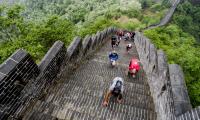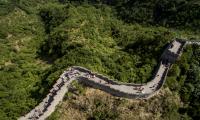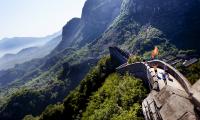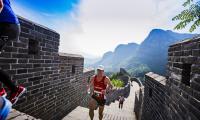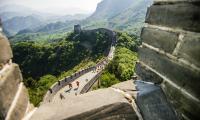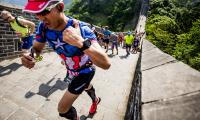Great Wall Marathon Training Tips
All Levels of Experience Welcome – But Training is Essential
First and foremost, it should be clearly stated – all levels of experience, from walkers to experienced runners, can conquer the challenging Great Wall Marathon!
Albatros Adventure Marathons are about taking running to another level. The philosophy is to offer challenges in beautiful surroundings and varying terrain. The focus is on great experiences, pushing your own limits and achieving something extraordinary.
The Great Wall Marathon features three races:
• Marathon (42.2km / 26.2mi)
• Half-marathon (21.1km / 13.1mi)
• 8.5km Fun Run (5.5mi)
However, regardless of your chosen distance, it's essential that you’ve trained for the terrain, and come prepared for the mental test.
You can do this! Ready to push your limits?
Route Highlights – Marathon, Half-Marathon & Fun Race
All events in The Great Wall Marathon start from the Yin and Yang square in the old Huangyaguan fortress. Along each route, runners should expect many staircases, rolling trails, historic cobblestone paths, unpaved terrain, steep ascents and descents, time spent in both natural surroundings and many supportive locals.
Check out Race Info for a clear picture of the elevation map and route.
Marathon
• Distance: 42.2km / 26.2mi
• Total steps on the Great Wall: 5,164
• Highlights: Marathoners will face the Great Wall two times, first east to west and later, west to east. This also means runners will complete a 700m descent and ascent on the infamous “Goat Track”. Runners can look forward to time along the river and in small countryside villages, where welcoming locals provide a boost of energy with cheers and high-fives.
Half-marathon
• Distance: 21.1km / 13.1mi
• Total steps on the Great Wall: 2,582
• Highlights: Half-marathoners will face the Great Wall once, east to west, and complete an extremely steep 700m descent on the infamous “Goat Track”. Runners can also look forward to time along the river and in small countryside villages, where welcoming locals provide a boost of energy with cheers and high-fives.
Fun Run
• Distance: 8.5km / 5.5mi
• Total steps on the Great Wall: 2,582
• Highlights: Runners in the Fun Race will take on the Great Wall one time, east to west, followed by an extremely steep 700m descent on the infamous “Goat Track”. After rounding the fortress walls, the route returns to the finish line and runners find themselves surrounded by cheering onlookers in Yin and Yang Square.
A Quick Comparison
Unlike a traditional city marathon, which usually has a flat and fast route, The Great Wall Marathon is the opposite. In this adventure race, you can expect a hilly route in spectacular surroundings with a lot of steps (marathoners will conquer 5,164 to be exact!).
Since this event is so different from a regular city marathon, it’s smart to follow a training program that focuses on both the unique terrain and the distance.
Remember Distance Training
Firstly, to put it in perspective, let’s talk about marathon training in general.
As participants, you all have different prerequisites to help you meet your goals and finish the marathon, half-marathon or 8.5km Fun Run.
Some might train three times a week, while others train every day. Your training style might differ as well with some preferring long, steady endurance runs, while others emphasize intensity.
For example, when I was in peak condition and ran my best marathon time of 2:09:43, 93% of my training consisted of aerobic and endurance work, while 7% was dedicated to speed and conditioning work, including races (anaerobic workouts).
On average, a typical runner uses about 98-99 % of their energy on aerobic processes during a marathon, while the remaining 1-2% consists of anaerobic processes. For this reason, I recommend your core training program consists of aerobic workouts. This means moderately-paced runs where you use 60-70 % of your capacity. See the fact box below
When developing your training plan for the Great Wall Marathon, be sure to also account for the elevation, stairs and hilly terrain that you will face. Here are a few tips to help you incorporate these elements.

Hill Training
You must come prepared for the stairs and changing elevation. Hill training can be done in many different ways, but the gentlest method is to run regularly in hilly terrain.
If you’re accustomed to hilly terrain with ascents that are comparable to those on the Great Wall Marathon route, you’ll be fine. However, if you live in a flat area, it’s very important to find training areas with hills approximately 50-100 meters in height.
If you are new to running in hilly terrain, ease into it. The first week should consist of short runs at a slow pace. If you complete these runs with little difficulty, increase the length of your next run on the hills.
One of your goals before the Great Wall Marathon could be to run one of your longer sessions in hilly terrain. But, bear in mind, you need to build up your stamina without getting injured. Participating in short races in hilly terrain is one great way to get ready for the Great Wall Marathon.
When training three times a week, include a slow-paced run in hilly terrain every other week.
When training five or more times a week, include a slow or moderately paced run in hills every week. For the very well-trained runner, your weekly hill run can include speed conditioning and speed training as well.
Stair Training
For those who do not have hills in their area, stair training is a good alternative – however, like any training program, ease into it… don’t start your first stair training session in a skyscraper! Be careful with too many stairs as it can produce strain on the body. Take particular care of your Achilles tendon so as not to injure yourself.
For example, start at work, where you can walk up and down the stairs. Thereafter, begin to jog up and down the stairs and give a little extra sprint at the end. Most importantly, increase your speed and the number of stairs gradually to help prevent undue injury.
If you don’t have access to stairs, you can strengthen your feet and ankles by skipping or running in sand. If you live near a beach, take off your shoes and run bare feet in the sand. Training in sand can consist of jogging or interval training. Nevertheless, always remember to build your strength and speed gradually to avoid injury.
You can also make use of your local gym and use the step machine for stair training. The step machine will strengthen your buttocks, thighs and calves, and unlike regular stair workouts, it’s gentler on your Achilles tendon.
Good luck with your Great Wall Marathon training - and best wishes for a great race!



